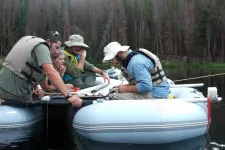(Press-News.org) Analyzing how people move about in their daily lives has long been important to urban planners, traffic engineers, and others developing new infrastructure projects.
But amid the social restrictions and quarantine policies imposed during the global spread of COVID-19--which is directly linked to the movement of people--human mobility patterns changed dramatically.
To understand just how COVID-19 affected human movement on a global scale, Shouraseni Sen Roy, a professor in the College of Arts and Sciences Department of Geography and Sustainable Development, and graduate student Christopher Chapin developed COVID-19 vs. Human Mobility, an innovative and interactive web application that, shared in a new study, shows the connections between human mobility, government policies, and cases of COVID-19.
"At a macro level, understanding movement patterns of people can help influence decision making for higher-level policies, like social gathering restrictions, mask recommendations, and tracking and tracing the spread of infectious diseases," said Sen Roy. "At a local level, understanding the movement of people can lead to more specific decisions, like where to set up testing sites or vaccination sites."
Using a collection of big data sets, Chapin, who in May earned his Master of Science in Business Analytics with a minor in geospatial technology, developed the web application from three independent sources: Apple Maps, which provides data on human movement via walking, driving, and public transportation; Oxford University's COVID-19 Government Response Tracker, which provides data on government policies implemented during the pandemic; and global cases of COVID-19 gathered by Johns Hopkins University.
"Putting together this data application was a very ambitious project," said Chapin, the lead author of the study in the Journal of Geovisualization and Spatial Analysis. "I'm really proud of the end result and grateful that Dr. Sen Roy pushed me to get the application published. Now other researchers can access the massive amount of data on COVID-19 and human mobility on a global scale."
Users of the interactive web application can select a country, or a specific state or county in the U.S. and view comparisons between human mobility and COVID-19 cases across time. They also can view information on government policies in relation to the spread of COVID-19.
"Since the initial launch, we have continued to update the application with appropriate data at regular intervals," said Sen Roy. "The web application produces interesting visualizations that can reveal fascinating trends specific to a given area that might otherwise not be recognized."
During their exploration of the data, the researchers found a handful of case studies that suggested interesting trends. For example, in New Orleans, the application shows a spike in human mobility at the end of February 2020, which coincided with Mardi Gras celebrations. Coincidentally, there was a corresponding spike in COVID-19 cases almost a month after the event.
"We are hoping to garner more conversation and interest in the application that can help us and other researchers continue to see how COVID-19 has and continues to impact our world," said Sen Roy.
Although the application is specific to the pandemic, she noted that the framework could be modified rather easily to create a similar application for natural disasters--as long as appropriate data sets are available.
"Understanding historic mobility patterns, both under normal circumstances and in response to extreme events like a pandemic or a natural disaster, is surely needed for policy makers to make informed decisions regarding transportation systems and more," she said. "In this context, we hope that our application can be of use."
INFORMATION:
The study, "A Spatial Web Application to Explore the Interactions between Human Mobility, Government Policies and COVID-19 Cases," is available online.
In polymicrogyria, the cortex of the brain has many irregular, small folds (gyria) and disorganization of its layers. Many affected children have severe developmental delay, intellectual disabilities, and epilepsy, and many need to use a wheelchair. Mutations in several different genes can cause this "overfolding of the brain" condition.
Studying four patients with polymicrogyria, Richard Smith, PhD, identified mutations in a gene that caused him to do a double-take. His curiosity drove him to investigate the role of this gene, called ATP1A3, in the developing brain.
"ATP1A3 is critical to many cell biological processes," says Smith, an investigator the Division of Genetics and Genomics at Boston Children's Hospital. ...
Those who deactivated their Facebook profiles report a lower regard for other ethnic groups, and this effect was more prevalent among people living in more ethnically homogenous areas, shows a new study of users in Bosnia and Herzegovina (BiH). The findings run counter to a commonly held view that social media usage exacerbates societal polarization.
The work, conducted by researchers at New York University's Center for Social Media and Politics (CSMaP), appears in the Proceedings of the National Academy of Sciences (PNAS).
"For all our attention to the online drivers of polarization, we should not forget about the importance of offline factors as well," ...
MISSOULA - Following 2020's extreme fire season, high-elevation forests in the central Rocky Mountains now are burning more than at any point in the past 2,000 years, according to a new University of Montana study set to publish in the Proceedings of the National Academy of Sciences.
Researchers from UM and the University of Wyoming analyzed a unique network of fire-history records to understand how 21st-century fire activity compares to wildfires in the past. The findings highlight that burning in recent decades in high-elevation forests of northern Colorado and southern Wyoming is unprecedented over the past several millennia.
As fire paleoecologists - scientists who study historical ecosystems - the team uses charcoal found in lake sediments to piece together the fire ...
PULLMAN, Wash. - You can take a fish out of toxic water, but its epigenetic mutations will remain for at least two generations.
A research team led by Washington State University scientists analyzed the epigenetics--molecular factors and processes that determine whether genes are turned on or off--of a group of Poecilia mexicana fish, or Atlantic molly, that live in springs naturally high in hydrogen sulfide, which is normally toxic to most organisms.
The researchers removed a sample of fish from the toxic water and bred them in freshwater. They found that the grandchildren of the sulfidic-adapted fish had more epigenetic marks ...
EVANSTON, Ill. --- The human gut is more than a source of instinct.
A new Northwestern University study is the first to explicitly address the gut microbiome as a pathway to understanding how environmental inequities could lead to health disparities.
Biological anthropologist Katherine Amato, assistant professor of anthropology at the Weinberg College of Arts and Sciences at Northwestern, is the study's lead author.
Amato says, despite a rich body of literature documenting environmental impacts on the microbiome, and the microbiome's impact on human health, ...
International team used the stomach bacteria Helicobacter pylori as a biomarker for ancient human migrations
DNA sequences catalogued at University of Warwick in EnteroBase, a public genomes database, demonstrate that a migration of Siberians to the Americas occurred approximately 12,000 years ago
Project began in 2000s but new statistical techniques allowed researchers to reconstruct and date the migrations of Siberian Helicobacter pylori
Early migrations of humans to the Americas from Siberia around 12,000 years ago have been traced using the bacteria they carried by an international team including scientists at the University of ...
Certain patients with an aggressive form of ovarian cancer have a better chance of a cure through surgical removal of their tumor before chemotherapy instead of the reverse, a new study shows.
Led by researchers at NYU Grossman School of Medicine, Perlmutter Cancer Center, and Dana-Farber Cancer Institute, the study used a mathematical tool to examine how doctors should coordinate available treatments for high-grade serous ovarian cancer (HGSC).
Ovarian cancer is the 8th most common cancer and cancer death in women worldwide, and HGSC constitutes roughly 70 percent of ovarian malignancies and has the worst prognosis. Patients with the condition typically undergo surgery and chemotherapy, but there has been long-standing controversy over the best order of treatment.
Published ...
A study of woodland ecosystems that provide habitat for rare and endangered species along streams and rivers throughout California reveals that some of these ecologically important areas are inadvertently benefitting from water that humans are diverting for their own needs. Though it seems a short-term boon to these ecosystems, the artificial supply creates an unintended dependence on its bounty, threatens the long-term survival of natural communities and spotlights the need for changes in the way water is managed across the state.
"We need to be more intentional in incorporating ecosystem water needs when we manage water--both for aquatic organisms and species on land," said Melissa Rohde, the lead author of a study published June ...
The concentration of potentially toxic metals is increasing in the population of the franciscana dolphin --a small cetacean, endemic from the Rio de la Plata and an endangered species-- according to a study led by a team of the Faculty of Biology and the Biodiversity Research Institute (IRBio), published in the journal Science of The Total Environment.
The impact of human activity in the region could be the cause for the increase of trace elements such as chromium, copper, iron and nickel in the dolphins' biological tissues, as stated in the study. The paper counts on the participation of members from the National History Museum of Uruguay, and is subsidized through a project of ...
LAWRENCE -- The United States has the highest population of incarcerated citizens among developed nations. Every year, roughly 2 million women, the majority held in jails, leave incarceration. The COVID-19 pandemic hit jails and correctional facilities harder than almost any other societal setting. Many of the people leaving incarceration are returning to communities that were also disproportionately affected by the pandemic, yet many people in that population have expressed hesitancy to receive a COVID-19 vaccine.
New research from the University of Kansas found high rates of vaccine hesitancy among women transitioning from incarceration, due to a multitude ...



